Abstract
Real-time health assessments are of great importance for the safe and stable operation of in-orbit swarms. To solve the problems of existing real-time health assessments of microsatellite swarms, such as the difficulty of selecting a multisource and assessment calculation normalization, this paper proposes a real-time health assessment method applicable to mission-oriented swarms. The method divides the microsatellite swarm into three levels: single satellite, intersatellite communication link and swarm effectiveness, which establish a multilevel index system by adopting the reliability evaluation based on random failure and failure by loss, a health evaluation based on natural connectivity, and a real-time dynamic analysis based on swarm topology. For the swarm effectiveness during the mission, the multilevel index and the entropy weight method are used to construct the effectiveness evaluation model of the whole swarm, and the health state evaluation of the swarm is realized based on the variable weight principle. The simulation results show that this method can quantify the health state of the microsatellite swarm in real-time, and it can predict the health state after the fault without maintenance.
1. Introduction
Mission-oriented microsatellite clustering technology has become one of the future trends in space technology development due to its advantages in mission executability, system robustness, and polarizability [1,2,3]. However, with the dramatic increase in the size of the satellites in orbit, the stability, safety, and reliability of the on-orbit operation of the swarm are challenged [4], and the need for health management techniques for satellite swarms is imminent. In general, a satellite swarm consists of multiple satellites in concert, and the failure of a few satellites cannot be considered the failure of the whole swarm. Since assessing the swarm status is a prerequisite for in-orbit management, health assessment is of great significance for the swarm health management [5].
The in-orbit real-time assessment of satellite swarm health status has been a difficult task in the field of health management. The current research objects of in-orbit health assessment are mainly spacecraft key components and control systems, which are usually studied based on mathematical models or data. For the satellite attitude control system (ACS), G. Li et al. [6] improved the fuzzy synthetic evaluation (FSE) method for a quantitative assessment of the satellite attitude control system health, including dimensionless processing of specified characteristic parameters (CPs), rule-based evaluation, and common fuzzy synthetic assessment. Fei S et al. [7] proposed a real-time in-orbit health assessment method for satellite attitude control systems based on multilevel fuzzy comprehensive evaluation architecture, which can realize the health assessment of attitude control systems. Haiming Qi et al. [8] introduced the concept of degraded state or partial failure, thoroughly analyzed the effects of different failures of the system, and constructed a satellite attitude control system Petri network model, and the remaining lifetime can be predicted by a large number of simulations. In the evaluation studies of swarms, the study of the effectiveness assessment dominates. However, the aforementioned studies rely on experts and large amounts of data, which lack objectivity and practicality. Y Xiong et al. [9] proposed a health assessment algorithm combining support vector machine (SVM) and cloud model to achieve spacecraft power control system health state measurement as a support for online health assessment and operational decision making of power critical components. B Pilastre et al. [10] introduced a convolutional sparse model for anomaly detection in mixed continuous and discrete data, based on evaluation on a representative dataset composed of real spacecraft telemetry. Such methods incorporate intelligent algorithmic techniques, and although they are effective for health assessment, they are difficult to model and represent the impact of components on the swarm. In contrast, research on effectiveness assessment dominates for swarm systems. Cheng S [11] summarized the current research on the satellite communication system performance evaluation and proposed the prospect of applying neural networks in the satellite communication system performance evaluation. Lorenzo Olivieri et al. [12] studied the risk of space debris caused by large constellation programs, which may collide with the constellation itself, and proposed a scheme to assess the vulnerability of the constellation system, so that the lifetime can be maximized. Although the above-mentioned literature assesses the communication status and collision risk of the constellation system, it is not enough to reflect the overall health of the constellation.
To address the above issues, this paper proposes a real-time health assessment algorithm that integrates single satellite, intersatellite communication links, and swarm mission effectiveness based on the time-varying characteristics of mission-based swarm topology. Compared with the spacecraft assessment algorithm, this method fully considers the influence of intersatellite communication and swarm effectiveness on the health state. Firstly, the swarm health status is defined and an evaluation model is developed. Secondly, we calculate the health state based on the single satellite, the intersatellite communication and the swarm effectiveness. Then, the principle of variable power is introduced to deal with the case of unexpected failure. Finally, the method is applied to a swarm of modular microsatellites performing autonomous stitching missions. The health degree calculation and health state assessment of the time-varying swarm are realized by simulation.
2. Swarm Health State Model
2.1. Model of the Health State
The health status of a swarm of microsatellites is time-varying, and for this reason, the health degree () is used to quantify its health. Swarm health () is defined as the degree of resistance to the destruction of the constituent elements and swarm topology and the degree of the ability to meet mission requirements within a continuous-time. Based on the above analysis, the swarm can be divided into three parts: single satellite, intersatellite communication link, and swarm effectiveness, but the swarm topology is complex and intertwined, and each part affects the others. Therefore, the health of a microsatellite swarm can be expressed in a triad as
where is the total health of all individual stars in the swarm system, is the total health of the intersatellite communication links, and is the swarm effectiveness, which indicates the degree of mission accomplishment. indicates that the health of the swarm system is determined by a mathematical relationship between the three parameters.
2.2. Determination of Health Levels
To describe the health state intuitively and reduce the computational complexity, the health state is divided into three health classes: Health (H), Sub-Health (SH), and Fault (F). The determination of the health classes belongs to the clustering problem by nature, for which three experts are invited to contribute to this paper, and the gray clustering method [13] is used to ultimately obtain the health state classes, as shown in Table 1.

Table 1.
Health status level.
3. Real-Time Health Assessment Algorithm
Since intersatellite links are usually bidirectional, based on graph theory [14], the topology of a swarm of microsatellites at a specific moment can be represented by an undirected graph as follows.
where is the set of all satellites in the swarm at moment t, is the set of interstellar communication links at moment t, and T is the lifetime of the swarm. Without loss of generality, the following assumptions are made for the swarm.
- All satellites are of the same type and model and are equivalent to nodes in a swarm system;
- The swarm contains N satellites and M communication links at t;
- The swarm has sensors that measure state quantities (three-axis positions, etc.), and they are capable of real-time error analysis against the desired values.
- The topology of the swarm is stable until the next change occurs after the topology of the swarm has been altered;
- The failure forms are transient failure and degradation failure.
3.1. Single Satellite Health Assessment Algorithm
For the health assessment of a single satellite in a swarm system, it is necessary to first consider the health of the single satellite itself, and then the degree of its impact on the system performance. The former uses a reliability analysis [15] to model the health of single satellites; the latter uses the method of topological node importance [16] to describe the degree of association between single satellite and the health of the swarm.
For a steady swarm topology diagram containing satellites and communication links given by , the following definitions are given.
Definition 1.
Interstellar distance: The shortest path between satelliteand satellite. When there is no link betweenand,→∞.
Definition 2.
Satellite tightness: The reciprocal of the sum of the distances of satelliteto all other satellites [15].
The satellite tightness evaluates the satellite importance from a system-wide perspective, which reflects the ease of access to other satellites in the swarm system, and the satellite importance increases with the increasing tightness.
Definition 3.
Satellite mesonumber: The ratio of the number of satellites passing through the shortest path of all pairs of satellites in the swarm topology [15].
whereis the number of shortest paths between satelliteand, is the number of passing satellitesin, and/is the contribution ofto the number of satellites andmediators, which can reflect the satellite position information.
Definition 4.
Swarm importance contribution matrix (SICM) [15].
where element 1 on the diagonal of the matrix represents the value of the satellite’s contribution to its importance; element/represents the value of thesatellite’s contribution to the importance of other satellites in the swarm topology.
Definition 5.
The importanceof satellite: depends on the location information of the satellite and its correlation with other satellites; thus, the satellite importance model consists of the satellite mesonumberand the satellitecontribution/together.
The normalization process leads to the following values of satellite importance weights.
To model satellite reliability, the failure rate is usually used as an indicator to characterize reliability, and the factors affecting health generally include sudden failure and attrition failure. According to the statistical data, the failure probability of a spacecraft satisfies the “bathtub curve” [17], so the Weibull distribution and the normal-terrestrial distribution are used here for failure simulation.
The satellite random failure reliability obeys the Weibull distribution as follows [17].
where η is the scale parameter, indicating the characteristic lifetime, and β is the shape parameter. The satellite loss failure reliability obeys a normal distribution as follows.
where μ is the expected value and σ is the standard deviation. Considering the reliability distribution of sudden failure and loss failure together, the satellite reliability model is as follows.
where denotes the reliability value of satellite in the swarm system. Combining the satellite reliability with the satellite weight values, the single-satellite health degree can be further collated as follows.
3.2. Interplanetary Communication Link Health Assessment
Assuming that information transmission delay and the packet loss are not considered and the channel has sufficient bandwidth, a destructiveness-based approach is generally adopted to confirm the link importance in the topology. The judging index is the natural connectivity [18], which reflects the redundancy of the intersatellite alternative paths and indicates the degree of intersatellite connectivity even after a link failure. Combining the above analysis, the following definition is given.
Definition 6.
Intersatellite correlation matrix: The elements of the matrix indicate the presence or the absence of communication links between satellites. If there is a link betweenand, ; otherwise,.
Definition 7.
The natural connectivity is: The average value of all characteristic roots ofconcerning the natural logarithm, the natural exponent [18].
whereis the characteristic rootof. The larger the natural connectivityis, the more resistant the connection is to destruction. When the linkfails, the recalculated natural connectivity is denoted by.
Definition 8.
Link importance: can indicate the link importance, and the expression is as follows.
The normalization process leads to the following link importance weight values.
In this paper, when performing link analysis, the default satellites are visible to each other, and only the reliability of the communication link transmission needs to be considered. According to the reliability knowledge, the intersatellite link reliability can be expressed as follows.
where denotes the failure rate of link , which can be obtained from the Monte Carlo simulation based on historical data. Combining the interstellar link reliability with the link weight values and further collating, the interstellar communication link health can be derived as follows.
3.3. Star Swarm Mission Effectiveness Assessment
Since the errors between the actual and the expected values of mission-based swarm telemetry data can reflect the degree of mission accomplishment, this paper adopts the hierarchical analysis method to construct a reasonable swarm effectiveness assessment model according to the principles of completeness, hierarchy, and feasibility. To reduce the computational complexity of the dimensionless processing and avoid taking up more satellite resources, the input data are selected as the three-axis position, three-axis attitude, and energy consumption with the expected errors. The steps are as follows.
Step 1: A reasonable model of the effectiveness evaluation index system is established, and the structure of the system is shown in Figure 1.

Figure 1.
Star Swarm Effectiveness Assessment Model.
In the figure, denotes the swarm effectiveness, the primary indicator denotes the effectiveness of satellite , and the secondary indicator denotes the status of indicator of satellite .
Step 2: Data are obtained with respect to the error between the measured and expected values of the metric.
Step 3: The entropy weighting method [19] is used to determine the weights of each index.
The entropy weight method in the objective assignment method is used to determine the weights of each index, which can reduce the interference of subjective factors. Assuming that the normalized value of each error of the secondary index is , the value of the secondary index weight is as follows [19].
The primary indicator weights are obtained from the following steps.
where denotes the information entropy of each secondary indicator, denotes the information utility value, and is the primary indicator weight value.
Step 4: The combined swarm effectiveness is calculated.
3.4. Variational Power Synthesis Theory
The weights calculated in the above assessment are constant, but the health status of each satellite in the swarm is dynamically changing, and the role of low-weight factors often becomes important when transient satellite failures occur. Therefore, it is necessary to introduce a variable weighting method to adjust the weights to overcome the limitations of the constant weight assessment.
Combining the literature [20] and assuming that is the state vector of factor , is the constant weight vector of factor , and is the state variable weight vector. The variable weight vector of factor can be obtained from the Hadamard product as follows.
where is determined by the expert based on the actual situation.
3.5. Health Assessment Based on Nonlinear Weighting and Time-Series Dependence
The uncertainty and ambiguity of the space environment enable a nonlinear evaluation of the satellite health state, considering that in a swarm system, the components of a single satellite, intersatellite communication link, and swarm effectiveness affect each other; moreover, the health degree of the current moment of the swarm is influenced by the health state of the previous moment, i.e., there is a time-series dependence relationship. Therefore, a nonlinear weighting method [21] is used to construct the swarm health model under temporal dependence as follows.
where σ is the time series function and is the influence parameter obtained from the degree of influence of each part of the swarm system. The primary exponential smoothing method was chosen and fitted to the health degree values obtained from several consecutive trials.
where is the weighting factor, which is generally obtained by fitting with historical data and satisfies . The complete swarm health state assessment algorithm is shown in Figure 2. The process is as follows: firstly, single satellite, intersatellite communication and effectiveness assessment parameters are entered. Next, the health is calculated by the health assessment algorithm. Then, failure analysis is performed by variable weights. Finally, the health assessment results are output by the nonlinear synthesis.
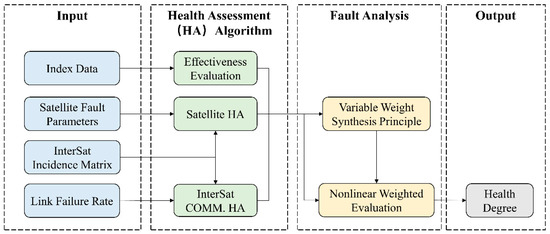
Figure 2.
Structural diagram of the star swarm health state assessment algorithm.
4. Simulation and Analysis
To verify the effectiveness of the evaluation algorithm, this paper analyzes the health status of the swarm in the context of the task for stitching the main mirror of a space telescope by a swarm of stars in orbit, and the task scenario is shown in Figure 3. The parent platform releases modular microsatellites in the target orbit, and the swarm performs the task of stitching the primary mirror, which eventually changes into a space telescope from the initial disorderly distribution. This process can be divided into three stages: the initial stage, the stitching procedure and the completion of the stitching. The dashed box indicates the relationship between the single satellite, the intersatellite communication topology, and the swarm effectiveness.

Figure 3.
Schematic diagram of the autonomous stitching swarm health state model.
4.1. Simulation Parameters
In this paper, MATLAB software is used to evaluate the health status of the swarm in the above scenario. The parameters of the swarm model are set as shown in Table 2, and the parameters of the effectiveness evaluation index are shown in Table 3.

Table 2.
Star swarm model parameters.

Table 3.
Performance evaluation index parameters.
4.2. Simulation Results
4.2.1. Normal-to-Life Health Assessment Simulation
Assuming that the on-orbit operational lifetime of the swarm reaches the normal operating time, i.e., normal to life, a health assessment of the swarm is performed to verify the validity of the assessment algorithm in the following steps.
- According to Equations (8)–(10), the reliability curve of a single satellite is shown in Figure 4a;
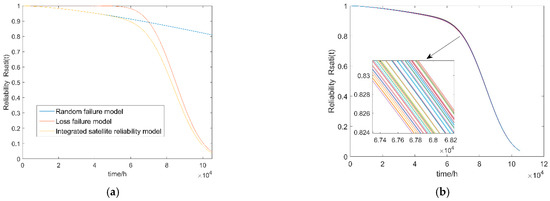 Figure 4. Single-satellite reliability curves for star swarms: (a) Satellite reliability model; (b) Reliability models for all satellites in the swarm.
Figure 4. Single-satellite reliability curves for star swarms: (a) Satellite reliability model; (b) Reliability models for all satellites in the swarm. - Combining Equations (3)–(7) and calculating the weights of each satellite, the reliability curves of all satellites of the swarm can be obtained, as shown in Figure 4b;
- Similarly, from Equations (12)–(16), we can find the weight values of each satellite and communication link in the swarm, and then obtain the reliability curves of all intersatellite communication links, as shown in Figure 5;
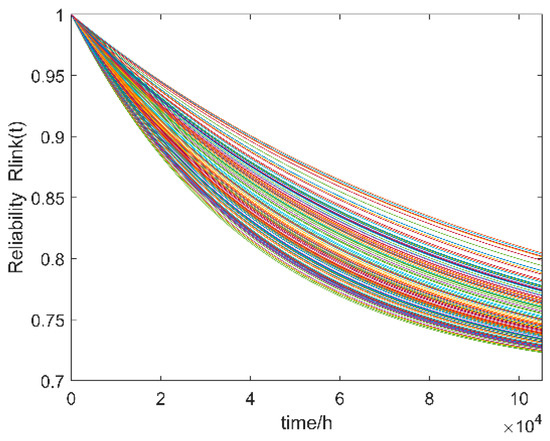 Figure 5. Interplanetary communication link reliability model.
Figure 5. Interplanetary communication link reliability model. - Finally, the weight values and the reliability model parameters are substituted into Equation (25) to derive the health curves of the star swarm in Figure 6.
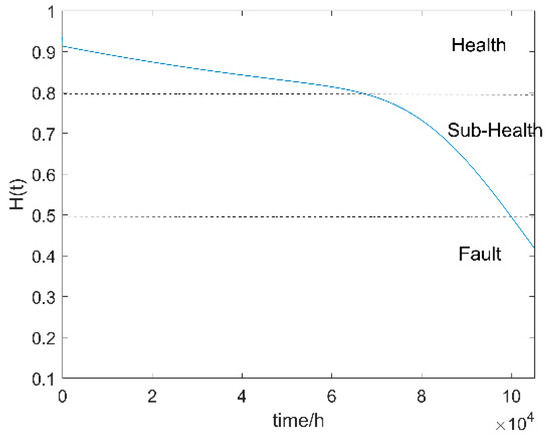 Figure 6. Swarm health curve model.
Figure 6. Swarm health curve model.
As observed from Figure 6, the health of the swarm first decreases smoothly with time in the normal-to-life condition, and then enters the Subhealth stage from the Health stage at approximately 6.7 × 104 h. The health changes to a rapid decline at this stage and enters the failure-prone stage at approximately 9.8 × 104 h (approximately 11 years), and the whole process is consistent with the general spacecraft failure “horsetail curve”. The general swarm works together to form a virtual large satellite, and thus, the health state of the swarm is similar to that of a general large satellite, which further demonstrates the effectiveness of the real-time health assessment algorithm in this thesis.
4.2.2. Simulating a Health Assessment in Case of Failure
Three points of time (, , ) are selected: the initial moment of autonomous splicing, the moment of splicing progress, and the moment of splicing completion. Then, the variable-weight Equation (22) is used to perform fault analysis for the swarm. The simulation conditions are as follows.
- The center of the communication range of the initial distribution is the origin of the coordinate system.
- The small sphere and the square hexagonal prism represent the unstitched and the stitched satellites, respectively, and the large transparent sphere represents the star swarm.
- Red indicates malfunction, and yellow and green indicate subhealth and health status, respectively.
For the three selected moments , , , the health status assessment is carried out assuming that there is no satellite failure, eight satellite failures, and twenty satellite failures, and the results are obtained as shown in Figure 7, Figure 8 and Figure 9.
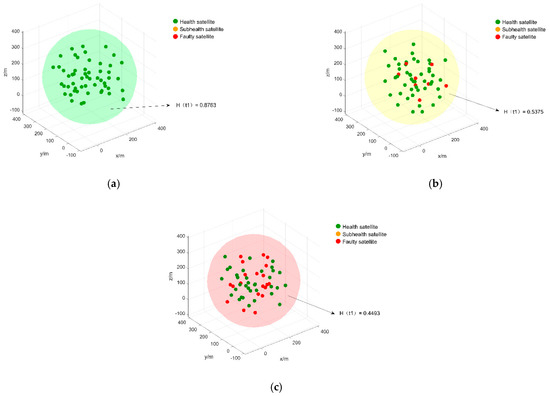
Figure 7.
Health assessment results at moment t1: (a) No satellite failure case; (b) Eight satellite failure case; (c) Twenty satellite failure case.
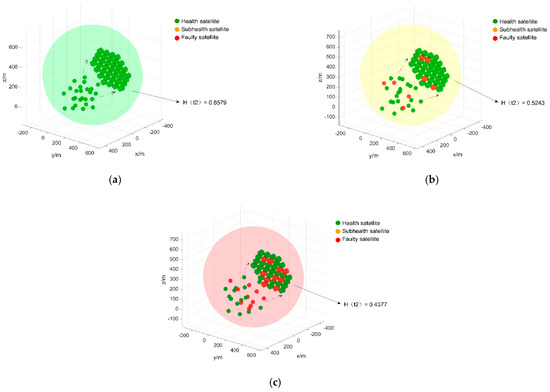
Figure 8.
Health assessment results at moment t2: (a) No satellite failure case; (b) Eight satellite failure case; (c) Twenty satellite failure case.
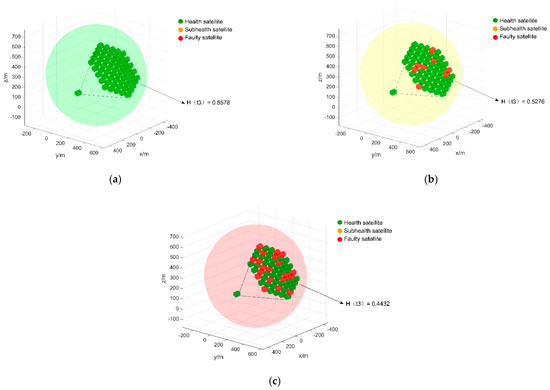
Figure 9.
Health assessment results at moment t3: (a) No satellite failure case; (b) Eight satellite failure case; (c) Twenty satellite failure case.
Simulations for three moments show that the swarm health decreases with the number of simultaneous failed satellites. At the initial moment, the swarm health for no satellite failure drops to 0.5375 for eight satellite failures and drops to 0.4493 for twenty satellite failures. At the splicing moment, the swarm health for no satellite failure drops to 0.5243 for eight satellite failures and drops to 0.4377 for twenty satellite failures. After the stitching is complete, the swarm health for no satellite failure drops to 0.5276 for eight satellite failures and drops to 0.4432 for twenty satellite failures.
Figure 10a,b show the swarm health curves from the satellite’s failure and communication link failure, respectively. It can be seen from the figures that the swarm health decreases instantaneously after a fault launch, and the satellite’s fault exhibits a more fluctuating effect on the swarm health than the communication link fault. Swarm health is more dependent on the satellite’s health. In fact, by establishing the above health state model and the fault model, the impacts of other faults on the swarm can be analyzed, which represents a good guideline for swarm health state assessment.
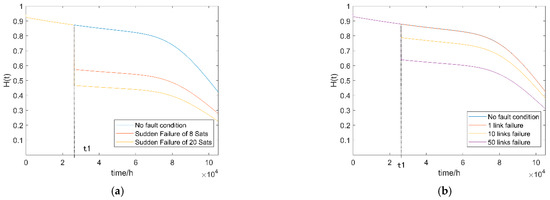
Figure 10.
Swarm health-time curve: (a) Satellite transient failure; (b) Communication link transient failure.
5. Conclusions
In this paper, a nonlinear weighted real-time health assessment method is proposed for the mission-oriented microsatellite swarm health assessment based on the single-satellite state, intersatellite communication topology, and swarm effectiveness requirements, which solves the problem of difficult health evaluation caused by the complex swarm system. The simulation results show that the method is well justified, especially the introduction of communication links, which reduces the subjectivity of the evaluation. Based on the health assessment results, the extent to which each level of failure (different number of satellite failures, different number of communication link failures) affects the health of the swarm can be determined, so that maintenance strategies can be specified in a targeted manner. At the same time, through the health-state-time curve, it is possible to know the health-state of the swarm by knowing the working lifetime of the satellite swarm only. The accuracy of swarm health assessment can also be improved by further enriching the fault states or further optimizing the nonlinear weighting process. It should be noted that only transient failure cases are considered in this paper. Swarm systems will spread and propagate failure information through communication links and are usually in a multi-failure and maintenance coexistence state, which make mission-oriented swarm health assessment studies more challenging.
Author Contributions
Conceptualization, G.K. and X.Y.; methodology, X.Y.; software, X.Y. and Z.Y.; validation, X.Y., J.W. and Z.Y.; writing—original draft preparation, X.Y.; writing—review and editing, G.K.; visualization, X.Y.; project administration, G.K.; funding acquisition, G.K. All authors have read and agreed to the published version of the manuscript.
Funding
This research was funded by The Open Project Program of Wuhan National Laboratory for Optoelectronics, grant number 2019WNLOKF011.
Institutional Review Board Statement
Not applicable.
Informed Consent Statement
Not applicable.
Data Availability Statement
Not applicable.
Conflicts of Interest
The authors declare no conflict of interest. The funders had no role in the design of the study; in the collection, analyses, or interpretation of data; in the writing of the manuscript, or in the decision to publish the results.
References
- Araguz, C.; Bou-Balust, E.; Alarcón, E. Applying autonomy to distributed satellite systems: Trends, challenges, and future prospects. Syst. Eng. 2018, 21, 401–416. [Google Scholar] [CrossRef]
- Yang, Z.; Wang, D.; Zhang, Y. Design of Optimal Routing for Cooperative Microsatellite Swarm Network. In Proceedings of the International Conference on Wireless and Satellite Systems, Nanjing, China, 17–18 September 2020; Springer: Cham, Switzerland, 2020. [Google Scholar]
- Le Moigne, J.; Adams, J.C.; Nag, S. A new taxonomy for distributed spacecraft missions. IEEE J. Sel. Top. Appl. Earth Obs. Remote Sens. 2020, 13, 872–883. [Google Scholar] [CrossRef]
- Del Portillo, I.; Cameron, B.G.; Crawley, E.F. A technical comparison of three low earth orbit satellite constellation systems to provide global broadband. Acta Astronaut. 2019, 159, 123–135. [Google Scholar] [CrossRef]
- Tang, X.; Yung, K.L.; Hu, B. Reliability and health management of spacecraft. In IoT and Spacecraft Informatics; Elsevier: Amsterdam, The Netherlands, 2022; pp. 307–335. [Google Scholar]
- Li, G.; Li, J.; Cao, Y.; Huang, H.; Li, X.; Wei, J.; Xia, K.; Dong, L. An Improved Fuzzy Synthetic Evaluation Method for Health State of Satellites’ Attitude Control System. In Proceedings of the 2019 IEEE 2nd International Conference on Automation, Electronics and Electrical Engineering (AUTEEE), Shenyang, China, 22–24 November 2019. [Google Scholar]
- Song, F.; Qin, S. On-orbit real-time health assessment of satellite attitude control system. J. Beijing Univ. Aeronaut. Astronaut. 2014, 40, 1581. [Google Scholar]
- Qi, H.; Jiang, B.; Lu, N.; Cheng, Y.; Xing, Y. The residual life prediction of the satellite attitude control system based on Petri net. In Proceedings of the 2014 Prognostics and System Health Management Conference (PHM-2014 Hunan), Zhangjiajie, China, 24–27 August 2014. [Google Scholar]
- Xiong, Y.; Jiang, Z.; Fang, H.; Fan, H. Research on Health Condition Assessment Method for Spacecraft Power Control System Based on SVM and Cloud Model. In Proceedings of the 2019 Prognostics and System Health Management Conference (PHM-Paris), Paris, France, 2–5 May 2019. [Google Scholar]
- Pilastre, B.; Silva, G.; Boussouf, L.; d’Escrivan, S.; Rodríguez, P.; Tourneret, J.Y. Anomaly detection in mixed time-series using a convolutional sparse representation with application to spacecraft health monitoring. In Proceedings of the ICASSP 2020-2020 IEEE International Conference on Acoustics, Speech and Signal Processing (ICASSP), Barcelona, Spain, 4–8 May 2020. [Google Scholar]
- Cheng, S.; Gao, Y.; Cao, J.; Guo, Y.; Du, Y.; Hu, S. Application of Neural Network in Performance Evaluation of Satellite Communication System: Review and Prospect. In Artificial Intelligence in China; Springer: Singapore, 2020; pp. 239–244. [Google Scholar]
- Olivieri, L.; Francesconi, A. Large constellations assessment and optimization in LEO space debris environment. Adv. Space Res. 2020, 65, 351–363. [Google Scholar] [CrossRef]
- Su, B.; Xie, N. Research on safety evaluation of civil aircraft based on the grey clustering model. Grey Syst. Theory Appl. 2018, 8, 110–120. [Google Scholar] [CrossRef]
- Bollobás, B.; Bollobas, B. Modern Graph Theory; Springer Science & Business Media: Berlin/Heidelberg, Germany, 1998; Volume 184. [Google Scholar]
- Gertsbakh, B.; Shpungin, Y. Models of Network Reliability: Analysis, Combinatorics, and Monte Carlo; CRC press: Boca Raton, FL, USA, 2016. [Google Scholar]
- Mo, H.; Deng, Y. Identifying node importance based on evidence theory in complex networks. Phys. A Stat. Mech. Its Appl. 2019, 529, 121538. [Google Scholar] [CrossRef]
- Saleh, J.H.; Castet, J.F. Spacecraft Reliability and Multi-State Failures: A Statistical Approach; John Wiley & Sons: Hoboken, NJ, USA, 2011. [Google Scholar]
- Estrada, E.; Hatano, N.; Benzi, M. The physics of communicability in complex networks. Phys. Rep. 2012, 514, 89–119. [Google Scholar] [CrossRef] [Green Version]
- Qiyue, C. Structure entropy weight method to confirm the weight of evaluating index. Syst. Eng. Theory Pract. 2010, 30, 1225–1228. [Google Scholar]
- Yu, G.-F.; Fei, W.; Li, D.-F. A compromise-typed variable weight decision method for hybrid multiattribute decision making. IEEE Trans. Fuzzy Syst. 2018, 27, 861–872. [Google Scholar] [CrossRef]
- Modarres, M.; Kaminskiy, M.P.; Krivtsov, V. Reliability Engineering and Risk Analysis: A Practical Guide; CRC Press: Boca Raton, FL, USA, 2009. [Google Scholar]
Publisher’s Note: MDPI stays neutral with regard to jurisdictional claims in published maps and institutional affiliations. |
© 2022 by the authors. Licensee MDPI, Basel, Switzerland. This article is an open access article distributed under the terms and conditions of the Creative Commons Attribution (CC BY) license (https://creativecommons.org/licenses/by/4.0/).